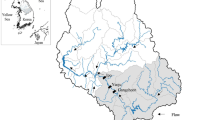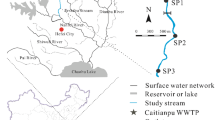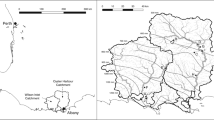Abstract
Sediment deposited in traps positioned along a sewage-impacted wetland receiving phosphorus (P)-retaining reactants from natural wetland water was fractionated into different particle sizes, and the amount of P retained in these particle sizes was investigated. Subsamples of the sediments collected from different sites along the wetland system were also equilibrated with water at different water:sediment ratios and equilibration periods to investigate the extent of P released from these sediments under aerobic and anaerobic conditions. Results obtained showed that most of P deposited in sediments is in fine fractions (<16 µm), particularly in sediments collected from confluence sites where water inflow from the natural wetland provides P-retaining reactants and from sites immediately below these confluence sites (postconfluence sites). The extent of P release from sediments depended on the aerobic-anaerobic conditions of the sediments, equilibration period, water:sediment ratio and the position of sites within the wetland. The rate of P released from sediments associated with an increase in equilibration period tended to be higher under aerobic than anaerobic conditions. Water:sediment ratio was found to be a more important factor in controlling the release of P from sediments under anaerobic than aerobic conditions. The amount of P released from the confluence and postconfluence sites was higher than that from other sites over a range of equilibration periods and water:sediment ratios under aerobic and anaerobic conditions.
Similar content being viewed by others
References
Cooke, J. G.: 1988, Hydrological Processes 2, 123.
Cooke, J. G.: 1992, J. Environ. Quality 21, 733.
Cooke, J. G, Cooper, A. B. and Clunie, N. M. U.: 1990, N.Z. J. Ecology 14, 37.
Cooke, J. G., Stub, L. and Mora, N.: 1992, J. Environ. Quality 21, 726.
De Best, J.: 1992, ‘The Effect of Redox Conditions on the Sorption of Phosphate on Iron’, M. Sc. Thesis, Agricultural University, Wageningen, The Netherlands.
Day, P. R.: 1965, ‘Particle Fractionation and Particle Size Analysis’, in: C. A. Black (eds), Methods of Soil Analysis, Part 1. Physical and Mineralogical Properties, including Statistics of Measurement and Sampling, Am. Soc. Agron., Madison, Wisconsin.
Furumai, H. and Ohgaki, S.: 1989, Water Res. 23, 677.
Gale, P. M., Reddy, K. R. and Graetz, D. A.: 1994, J. Environ. Quality 23, 370.
Hwang, C. P., Lackie, T. H. and Huang, P. M.: 1976, J. Water Pollut. Control Fed. 48, 2754.
Khalid, R. A., Patrick, Jr. W. H. and DeLaune, R. D.:1977, Soil Sci. Soc. Am. J. 41, 305.
Krairapanond, A., Jugsujinda, A. and Patrick, Jr. W. H.: 1993, Plant and Soil 157, 227.
Masscheleyn, P. H., Pardue, J. H., DeLaune, R. D. and Patrick, Jr. W. H.: 1992, Water Resour. Bulletin 28, 763.
Mitsch, W. J. and Gosselink, J. G. (eds.): 1986, Wetlands, Van Nostrand Reinhold, New York.
Mitsch, W. J., Cronk, J. K., Wu, X. and Nairn, R. W.: 1995, Ecological Applications 5, 830.
Murphy, J. and Riley, J. P.: 1962, Anal. Chim. Acta 27, 31.
Nichols, D. S.: 1983, J. Water Pollut. Control Fed. 55, 495.
Olsen, S. R. and Sommers, L. E.: 1982, ‘Phosphorus’, in: A. L. Page, R. H. Miller and D. R. Keeney (eds.), Methods of Soil Analysis. Part 2. Chemical and Microbiological Properties, Am. Soc. Agron., Madison, Wisconsin.
Paludan, C. and Jensen, H. S.: 1995, Wetlands 15, 365.
Patrick, W. H., Jr. and Khalid, R. A.: 1974, Science 186, 53.
Rapin, F., Tessier, A., Campell, P. G. C. and Carignan, R.: 1986, Environmental Science and Technology 20, 836.
Reddy, G. B. and Reddy, K. R.: 1993, Wetlands Ecology and Management 2, 171.
Reddy, K. R., Diaz, O. A., Scinto, L. J. and Agami, M.: 1995, Ecological Engineering 5, 183.
Richardson, C. J. and Craft, C. B.: 1993, ‘Effective Phosphorus Retention in Wetlands: Fact or Fiction?’, in: G. A. Moshiri (ed.), Constructed Wetlands for Water Quality Improvement, Lewis Publishers, Boca Raton.
Sharpley, A. N.: 1980, J. Environ. Quality 9, 521.
Sharpley, A. N., Ahuja, L. R., Yamamoto, M. and Menzel, R. G.: 1981, Soil Sci. Soc. Am. J. 45, 494.
Syers, J. K., Harris, R. F. and Armstrong, D. E.: 1973, J. Environ. Quality 2, 1.
Twine, J. R. and Williams, C. H.: 1971, Commun. Soil Sci. Plant Anal. 2, 485.
Author information
Authors and Affiliations
Rights and permissions
About this article
Cite this article
Nguyen, L.M., Cooke, J.G. & McBride, G.B. Phosphorus Retention and Release Characteristics of Sewage-Impacted Wetland Sediments. Water, Air, & Soil Pollution 100, 163–179 (1997). https://doi.org/10.1023/A:1018340028411
Issue Date:
DOI: https://doi.org/10.1023/A:1018340028411




